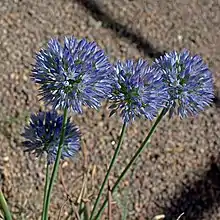| Allium caesium | |
|---|---|
 | |
| Scientific classification | |
| Kingdom: | Plantae |
| Clade: | Tracheophytes |
| Clade: | Angiosperms |
| Clade: | Monocots |
| Order: | Asparagales |
| Family: | Amaryllidaceae |
| Subfamily: | Allioideae |
| Genus: | Allium |
| Subgenus: | A. subg. Allium |
| Species: | A. caesium |
| Binomial name | |
| Allium caesium | |
| Synonyms[1] | |
| |
Allium caesium, light blue garlic, is a species of herbaceous perennial flowering plant native to central Asia (Xinjiang, Kazakhstan, Kyrgyzstan, Tajikistan, Uzbekistan). It grows in deserts and dry fields at elevations of 700–2,000 m (2,300–6,600 ft).[2]
Allium caesium is typically about 30–40 cm (12–16 in) tall, and grows best in full sun to partial shade.[3] It produces round bulbs up to 15 mm across. The scapes are up to 65 cm (26 in) tall. The leaves are round in cross-section, and slightly shorter than the scapes. The flowers are sky-blue.[2][4][5] They typically appear in the summer (June to August in England) and attract pollinators such as bees and butterflies.[6] The Latin specific epithet caesium means “grey-blue”.[7]
In cultivation in the UK, this plant has gained the Royal Horticultural Society’s Award of Garden Merit.[8] In the US it is suitable for hardiness zones 4-7.[9]
References
- ↑ The Plant List
- 1 2 Flora of China v 24 p 199
- ↑ "Allium caesium". Farmer Gracy. Retrieved 2021-05-27.
- ↑ Schrenk, Alexander Gustav von. 1844. Bulletin de la Classe Physico-Mathématique de l'Académie Impériale des Sciences de Saint-Pétersbourg 2: 113.
- ↑ Regel, Eduard August von. 1873. Gartenflora 22:236.
- ↑ "Allium caesium". Ballyrobert Gardens. Retrieved 2021-05-27.
- ↑ Harrison, Lorraine (2012). RHS Latin for Gardeners. United Kingdom: Mitchell Beazley. ISBN 978-1845337315.
- ↑ "Allium caesium". Royal Horticultural Society. 2002. Retrieved 5 January 2018.
- ↑ "Allium caesium". www.johnscheepers.com. Retrieved 2021-05-27.